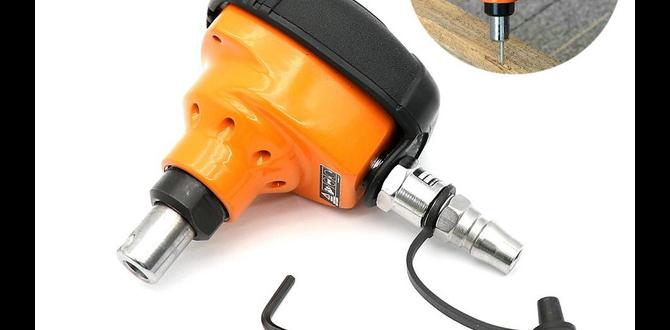Quick Summary:
Regular compressor maintenance ensures your nail gun runs smoothly and lasts longer. Simple steps like draining the tank, checking oil, and cleaning filters boost performance and prevent costly repairs. Keep your air compressor in top shape with these easy tips!
Hey there, fellow woodworkers and DIYers! Jack Shaffer here from Nailerguy. Ever had your nail gun sputter or your compressor act up right when you’re in the middle of a project? It’s a frustrating feeling, I know! A well-maintained air compressor is the heart of any nail gun operation, and keeping it in good shape doesn’t have to be complicated.
Think of your compressor like any other tool – it needs a little love and attention to perform at its best. Neglecting it can lead to weak nail drives, leaks, or even complete breakdowns, costing you time and money. Don’t worry, though! I’m going to walk you through the essential compressor maintenance tips specifically for nail gun users. We’ll cover everything from daily checks to routine servicing, making sure your air power is always ready when you are.
By the end of this guide, you’ll have the knowledge and confidence to keep your compressor humming along perfectly. Let’s dive in and make sure your tools always have the air they need!
Table of Contents
Why Compressor Maintenance Matters More Than You Think
Your air compressor is a powerful machine, and like any machine, it has parts that work hard. When these parts are well-cared for, your compressor delivers consistent air pressure, which is crucial for your nail gun to sink nails properly. A consistent air supply means you get clean, flush nail heads every time.
On the flip side, a neglected compressor can lead to a cascade of problems. Low air pressure can cause your nail gun to under-drive nails, leaving them sticking out. This is not only unsightly but can also be a safety hazard, especially during woodworking projects. Furthermore, moisture buildup inside the tank can lead to rust and corrosion, eventually causing leaks and damaging the tank itself.
Regular maintenance also prevents premature wear and tear on components like the motor, pump, and regulator. This means your compressor will last longer, saving you money on replacements. It also ensures safer operation, as faulty equipment can be dangerous. Let’s look at some of the key benefits:
- Consistent Performance: Ensures your nail gun works reliably with every trigger pull.
- Extended Lifespan: Prevents premature wear and component failure, making your investment last.
- Improved Safety: Reduces the risk of leaks, pressure issues, or mechanical failures that could cause injury.
- Cost Savings: Avoids expensive repairs and replacements due to neglect.
- Better Efficiency: A well-maintained compressor uses energy more effectively.
Essential Compressor Maintenance Schedule for Nail Gun Users
To keep things simple and effective, we can break down compressor maintenance into three main categories: daily or before-use checks, weekly/monthly tasks, and yearly or as-needed servicing. Sticking to a schedule like this makes it easy to remember what needs doing and when.
Before Each Use: Quick Checks for Peak Performance
These are simple, quick tasks you can do right before you plug in your compressor and start nailing. They take just a minute or two but can prevent big issues.
- Drain the Tank: This is perhaps the most critical daily task. Condensed water builds up in the compressor tank. Releasing this moisture prevents rust and corrosion from forming inside your tank. Look for the drain valve, usually located at the very bottom of the tank. Open it slowly to let the air and water out. You’ll hear a hiss. Close it once all the pressure is released or after a few seconds. Some modern compressors have automatic drain valves, but a manual check is always a good idea.
- Check Oil Level (for Oil-Lubricated Models): If your compressor uses oil, check the oil level before use. Most have a sight glass or a dipstick. Ensure the oil is between the minimum and maximum marks. Low oil can cause serious damage to the pump. If it’s low, top it off with the type of oil recommended by the manufacturer.
- Listen for Unusual Noises: While the compressor is running, listen for any strange sounds like knocking, grinding, or excessive rattling. These could indicate a problem that needs your attention.
- Inspect Air Hoses and Fittings: Quickly check your air hose for any cracks, kinks, or wear. Make sure all fittings are securely attached and not leaking air. A small leak can significantly reduce the air pressure available for your nail gun.
Weekly/Monthly Maintenance: Deeper Dive for Longevity
These tasks require a little more time but are vital for keeping your compressor in excellent condition over the long haul. The frequency depends on how often you use your compressor. If you use it daily, aim for weekly. If it’s more of a weekend warrior tool, monthly should suffice.
- Inspect and Clean the Air Filter: The air filter prevents dust and debris from entering the compressor pump. A clogged filter makes the compressor work harder and can reduce airflow. Depending on your model, it might be a simple paper element that you can tap clean or replace, or a foam filter that can be washed. Refer to your owner’s manual for the exact procedure for your compressor. A clean filter is key to efficient operation. You can often find good resources from manufacturers likeIngersoll Rand on maintaining their equipment.
- Check and Tighten Belts (Belt-Driven Compressors): If your compressor has a belt connecting the motor to the pump, check its tension. It should have a slight give but not be too loose. A loose belt can slip, reducing pump efficiency, while a tight belt can damage bearings. If a belt looks frayed or cracked, it’s time to replace it. Always unplug the compressor before inspecting or adjusting belts!
- Clean the Compressor Exterior: Dust and grime can build up on the compressor’s motor and pump, potentially causing overheating. Wipe down the exterior with a damp cloth. Ensure ventilation slots are clear of debris.
- Check the Safety Relief Valve: This valve is a critical safety feature. Periodically, you should manually pull the ring on the safety relief valve to ensure it’s not stuck. This releases a small burst of air, confirming the valve functions correctly. Do this while the compressor is running and pressurized, but be ready for the noise!
Annual or As-Needed Servicing: For Optimal Function
These are more in-depth maintenance tasks that you might not need to do very often, but they’re crucial for the long-term health of your compressor.
- Change the Oil (Oil-Lubricated Models): If you have an oil-lubricated compressor, it’s essential to change the oil periodically. The frequency depends on usage and the manufacturer’s recommendation, but annually is a good benchmark for most DIY users. Dirty oil loses its lubricating properties and can cause excess wear. Follow your owner’s manual for the correct procedure and types of oil. Disposal of used oil should be done responsibly; check local regulations for used oil recycling.
- Inspect and Clean Intake/Outlet Valves: Over time, carbon deposits can build up on the intake and outlet valves in the compressor pump. This can affect performance. If you’re comfortable with mechanical work and have the correct manual, you might be able to access and clean these. If not, this is a job for a qualified technician.
- Check and Clean Cooling Fins: The motor and pump often have cooling fins to dissipate heat. These can get clogged with dust and debris, reducing cooling efficiency. Gently clean them with a brush or compressed air.
- Inspect the Drain Valve Operation: Ensure the drain valve opens and closes smoothly. If it’s stiff or leaky, it might need cleaning or replacement.
Troubleshooting Common Compressor Issues for Nail Guns
Even with regular maintenance, you might encounter a few common problems. Here’s how to tackle them:
| Problem | Possible Causes | Solutions |
|---|---|---|
| Nail Gun Not Firing / Weak Nail Drive | Low air pressure in tank. Leak in air hose or fittings. Clogged air filter. Faulty regulator setting. Low oil in compressor (for oil models). | Check tank pressure and refill if needed. Inspect hose and fittings for leaks, tighten or repair. Clean or replace air filter. Adjust regulator to recommended setting. Check and add oil if necessary. |
| Compressor Not Building Pressure | Leaky drain valve. Worn pump piston rings or valves. Leaking head gasket. Faulty check valve. | Ensure drain valve is fully closed. May require professional service or pump rebuild. Inspect and replace gasket if damaged. Check and replace check valve. |
| Compressor Running Constantly | Air leak in the system (including tank). Faulty pressure switch. Dirty air filter. | Perform a leak test on the entire system. Test or replace the pressure switch. Clean or replace the air filter. |
| Excessive Moisture in Air Line | Infrequent tank draining. Humid operating environment. | Drain tank more frequently, especially after each use. Consider using an air dryer if operating in very humid conditions. |
| Strange Noises (Grinding, Knocking) | Loose motor or pump components. Worn bearings. Low oil level (oil models). | Tighten all accessible mounting bolts. May require professional bearing replacement. Check and top up oil level; if noise persists, seek professional help. |
Tools You’ll Need for Compressor Maintenance
You don’t need a massive toolkit for basic compressor maintenance. Here are some essential items:
- Adjustable Wrench: For tightening fittings, drain valves, and hose connections.
- Screwdrivers (Phillips and Flathead): For accessing air filters and other panels.
- Shop Rags or Microfiber Cloths: For wiping down the compressor and cleaning up spills.
- Gloves: To protect your hands, especially when dealing with oil or potential grease.
- Safety Glasses: Always wear safety glasses when working with pressurized air or tools.
- Penetrating Oil (Optional): Can help loosen stubborn drain valves.
- New Air Filter (if needed): Keep a spare for your specific compressor model.
- Compressor Oil (for oil-Lubricated models): Use only the type recommended by your manufacturer.
- Leak Detection Fluid or Soapy Water Solution: To find air leaks. Spray it on fittings and hoses, and look for bubbles.
Safety First! Important Reminders
Working with air compressors involves pressurized air, so safety is paramount. Always follow these guidelines:
- Always Unplug the Compressor: Before performing any maintenance, cleaning, or repairs, ensure the compressor is unplugged from the power source.
- Release All Air Pressure: After unplugging, open the drain valve to release any stored air pressure before working on the tank or other components.
- Wear Safety Glasses: Protect your eyes from debris, dust, or sudden air bursts.
- Never Point Air Hoses at Yourself or Others: Pressurized air can cause injury.
- Read Your Owner’s Manual: Each compressor model is slightly different. Your manual is the best resource for specific maintenance procedures and safety warnings. You can often find digital copies of these manuals on the manufacturer’s website. Reputable organizations like the Occupational Safety and Health Administration (OSHA) provide guidelines for safe tool operation.
- Allow the Compressor to Cool: If the compressor has been running for a while, components like the motor, pump, and exhaust can be hot. Let them cool down before touching.
When to Call a Professional
While most compressor maintenance is straightforward, there are times when it’s best to call in an expert. If you’re unsure about any procedure, if you encounter a problem beyond your comfort level, or if your compressor is making serious noises or not functioning at all after basic troubleshooting, it’s time to seek professional help. Complex issues like internal pump damage, electrical problems with the motor, or faulty pressure switch diagnostics are often best left to trained technicians. A qualified service center can ensure repairs are done correctly and safely.
This isn’t about being afraid to get your hands dirty; it’s about knowing your limits and respecting the power of these tools. A professional can also perform more in-depth diagnostics and maintenance that might not be covered in a DIY guide, potentially saving you from more significant problems down the line.
Conclusion
Taking care of your air compressor is a cornerstone of successful and enjoyable woodworking and DIY projects. By implementing these simple compressor maintenance tips for nail gun users, you’re not just extending the life of your equipment; you’re ensuring that every nail you drive into your project goes in perfectly, every time. Remember, a few minutes of upkeep can save you hours of frustration and costly repairs.
From draining that tank daily to giving your air filter a regular clean, these habits will become second nature. Your nail guns will thank you, your projects will look better, and you’ll have the peace of mind knowing your tools are always ready to perform. So, get out there, give your compressor some attention, and keep those projects moving forward with confidence!
Happy building!
– Jack Shaffer, Nailerguy
Frequently Asked Questions (FAQ)
Q1: How often should I drain my air compressor tank?
Answer: You should drain your air compressor tank at least once a day, or after every use. This removes accumulated moisture, which prevents rust and maintains tank integrity. If you use your compressor heavily, or in a humid environment, draining it more frequently is even better.
Q2: What kind of oil should I use for my air compressor?
Answer: Always use the type and weight of oil recommended by your air compressor’s manufacturer, as specified in your owner’s manual. Using the wrong oil can damage the pump. For most common DIY compressors, a specialized compressor oil (often labeled AW or 10W) is used. Never use motor oil unless explicitly stated by the manufacturer.
Q3: My nail gun isn’t getting enough power. What could be wrong with the compressor?
Answer: This is often due to low air pressure in the tank, a leak in your air hose or fittings, a clogged air filter that restricts airflow, or an incorrectly set regulator. Check your tank pressure, listen for leaks, clean or replace your air filter, and ensure your regulator is set to the appropriate PSI for your nail gun model.
Q4: My compressor is making a loud, unusual noise. What should I do?
Answer: Unusual noises like grinding or knocking can indicate mechanical issues. First, ensure the compressor is unplugged and check for any loose external parts. If the noise persists, especially after checking the oil level (for oil-lubricated models), it’s best to stop using the compressor and consult your owner’s manual or a qualified service technician for diagnosis and repair.
Q5: How often do I need to replace the air filter on my compressor?
Answer: The replacement frequency for an air filter depends on the environment where you use your compressor. In dusty conditions, you may need to clean it weekly or monthly and replace it every few months. In cleaner environments, it might last a year or longer. Always check your owner’s manual for specific recommendations and inspect it regularly for dirt buildup.
Q6: Do I need to change the oil in a “maintenance-free” compressor?
Answer: The term “maintenance-free” usually refers to oil-less compressors, meaning they don’t require oil changes because they use special self-lubricating materials in their pump. However, you still need to perform other maintenance tasks like draining the tank, cleaning the air filter, and checking hoses and fittings. Always refer to your specific compressor’s manual.



